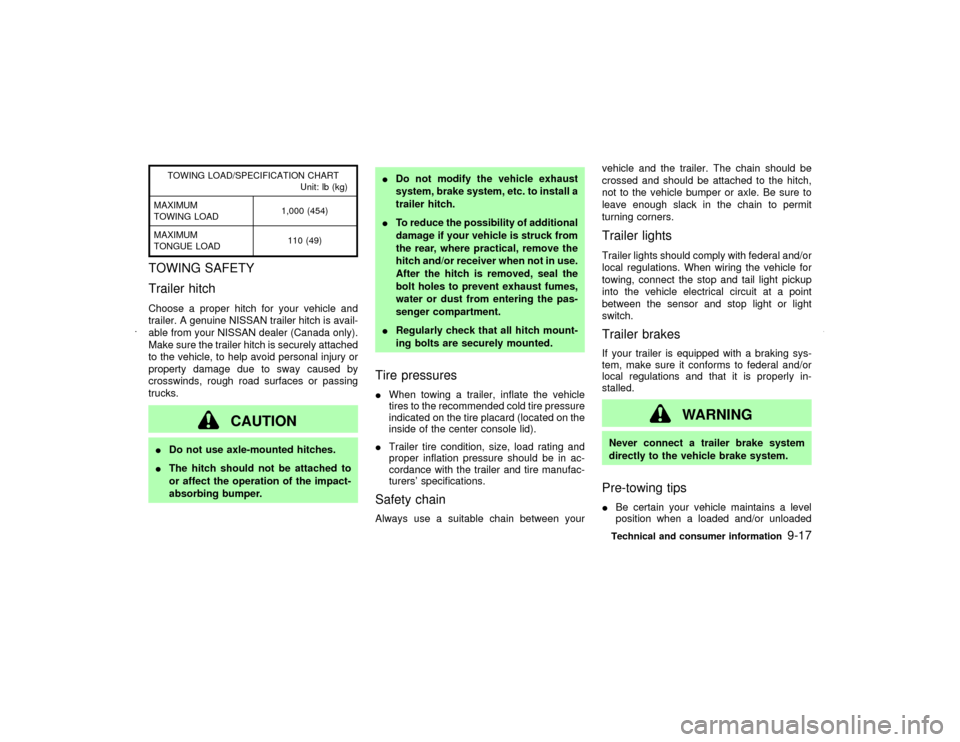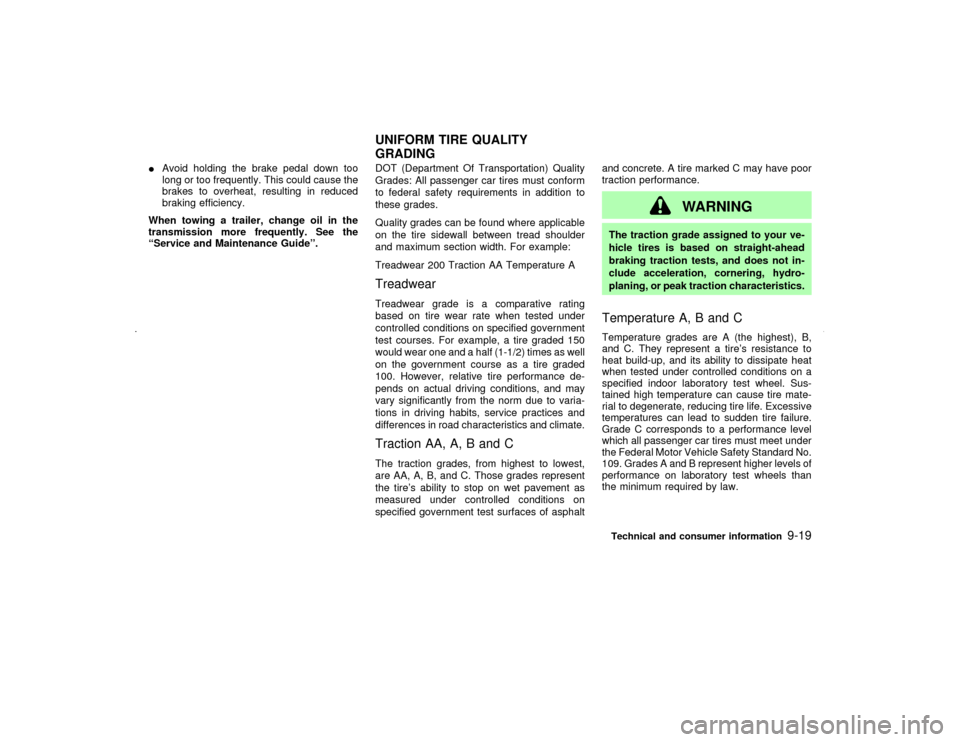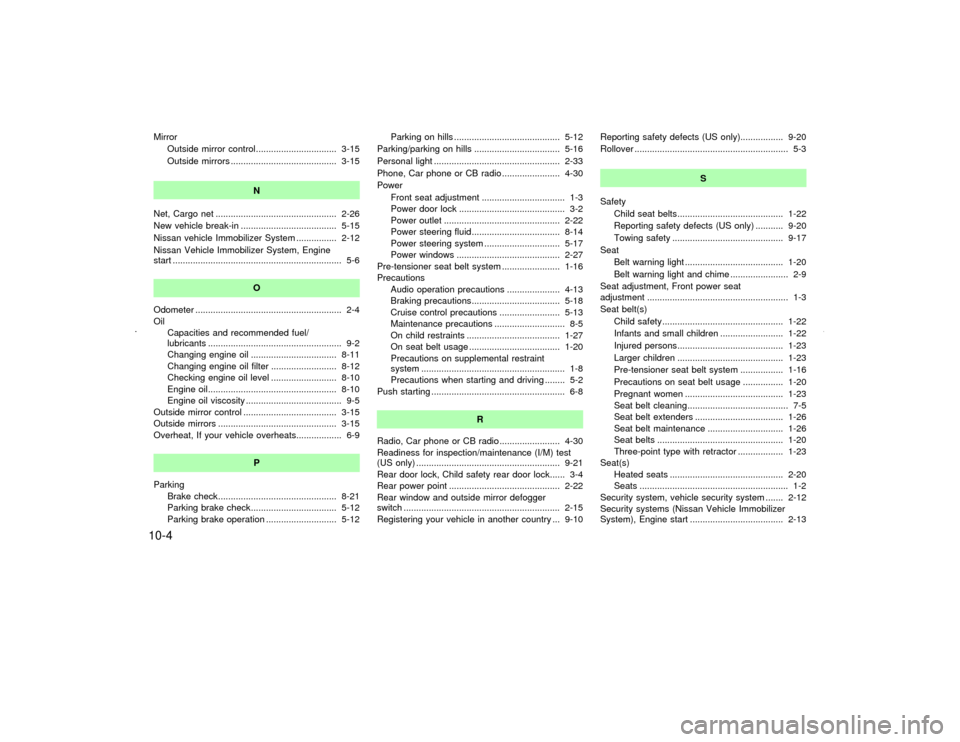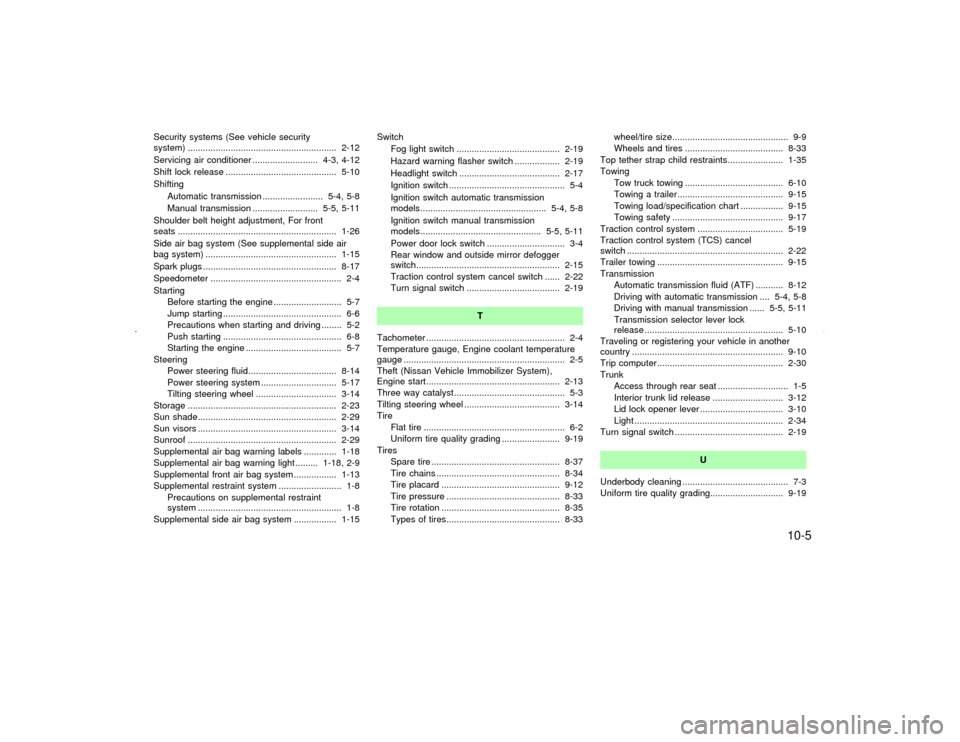2002 NISSAN MAXIMA tow
[x] Cancel search: towPage 232 of 247

TOWING LOAD/SPECIFICATION CHART
Unit: lb (kg)
MAXIMUM
TOWING LOAD1,000 (454)
MAXIMUM
TONGUE LOAD110 (49)
TOWING SAFETY
Trailer hitchChoose a proper hitch for your vehicle and
trailer. A genuine NISSAN trailer hitch is avail-
able from your NISSAN dealer (Canada only).
Make sure the trailer hitch is securely attached
to the vehicle, to help avoid personal injury or
property damage due to sway caused by
crosswinds, rough road surfaces or passing
trucks.
CAUTION
IDo not use axle-mounted hitches.
IThe hitch should not be attached to
or affect the operation of the impact-
absorbing bumper.IDo not modify the vehicle exhaust
system, brake system, etc. to install a
trailer hitch.
ITo reduce the possibility of additional
damage if your vehicle is struck from
the rear, where practical, remove the
hitch and/or receiver when not in use.
After the hitch is removed, seal the
bolt holes to prevent exhaust fumes,
water or dust from entering the pas-
senger compartment.
IRegularly check that all hitch mount-
ing bolts are securely mounted.
Tire pressuresIWhen towing a trailer, inflate the vehicle
tires to the recommended cold tire pressure
indicated on the tire placard (located on the
inside of the center console lid).
ITrailer tire condition, size, load rating and
proper inflation pressure should be in ac-
cordance with the trailer and tire manufac-
turers' specifications.Safety chainAlways use a suitable chain between yourvehicle and the trailer. The chain should be
crossed and should be attached to the hitch,
not to the vehicle bumper or axle. Be sure to
leave enough slack in the chain to permit
turning corners.
Trailer lightsTrailer lights should comply with federal and/or
local regulations. When wiring the vehicle for
towing, connect the stop and tail light pickup
into the vehicle electrical circuit at a point
between the sensor and stop light or light
switch.Trailer brakesIf your trailer is equipped with a braking sys-
tem, make sure it conforms to federal and/or
local regulations and that it is properly in-
stalled.
WARNING
Never connect a trailer brake system
directly to the vehicle brake system.Pre-towing tipsIBe certain your vehicle maintains a level
position when a loaded and/or unloadedTechnical and consumer information
9-17
Z
01.9.21/A33-D/V5.0
X
Page 233 of 247

trailer is hitched. Do not drive the vehicle if
it has an abnormal nose-up or nose-down
condition; check for improper tongue load,
overload, worn suspension or other pos-
sible causes of either condition.
IAlways secure items in the trailer to prevent
load shifts while driving.
IBe certain your rear view mirrors conform to
all federal, state or local regulations. If not,
install any mirrors required for towing be-
fore driving the vehicle.
Trailer towing tipsIn order to gain skill and an understanding of
the vehicle's behavior, you should practice
turning, stopping and backing up in an area
which is free from traffic. Steering stability, and
braking performance will be somewhat differ-
ent than under normal driving conditions.
IAlways secure items in the trailer to prevent
load shift while driving.
IAvoid abrupt starts, acceleration or stops.
IAvoid sharp turns or lane changes.
IAlways drive your vehicle at a moderate
speed.
IAlways block the wheels on both vehicle
and trailer when parking. Parking on aslope is not recommended; however, if you
must do so, and if your vehicle is equipped
with automatic transmission, first block the
wheels and apply the parking brake, and
then move the transmission selector lever
into the P (Park) position. If you move the
selector lever to the P (Park) position be-
fore blocking the wheels and applying the
parking brake, transmission damage could
occur.
IWhen going down a hill, shift into a lower
gear and use the engine braking effect.
When ascending a long grade, downshift
the transmission to a lower gear and reduce
speed to reduce chances of engine over-
loading and/or overheating.
IIf the engine coolant rises to an extremely
high temperature when the air conditioning
system is on, turn off the air conditioner.
Coolant heat can be additionally vented by
opening the windows, switching the fan
control to high and setting the temperature
control to the HOT position.
ITrailer towing requires more fuel than nor-
mal circumstances.
IAvoid towing a trailer for the first 500 miles
(800 km).
IHave your vehicle serviced more often thanat intervals specified in the recommended
maintenance schedule.
IWhen making a turn, your trailer wheels will
be closer to the inside of the turn than your
vehicle wheels. To compensate for this,
make a larger than normal turning radius
during the turn.
ICrosswinds and rough roads will adversely
affect vehicle/trailer handling, possibly
causing vehicle sway. When being passed
by larger vehicles, be prepared for possible
changes in crosswinds that could affect
vehicle handling. If swaying does occur,
firmly grip the steering wheel, steer straight
ahead, and immediately (but gradually) re-
duce vehicle speed. This combination will
help stabilize the vehicle. Never increase
speed.
IBe careful when passing other vehicles.
Passing while towing a trailer requires con-
siderably more distance than normal pass-
ing. Remember the length of the trailer
must also pass the other vehicle before you
can safely change lanes.
ITo maintain engine braking efficiency and
electrical charging performance, do not use
fifth gear (manual transmission) or over-
drive (automatic transmission).9-18
Technical and consumer information
Z
01.9.21/A33-D/V5.0
X
Page 234 of 247

IAvoid holding the brake pedal down too
long or too frequently. This could cause the
brakes to overheat, resulting in reduced
braking efficiency.
When towing a trailer, change oil in the
transmission more frequently. See the
ªService and Maintenance Guideº.DOT (Department Of Transportation) Quality
Grades: All passenger car tires must conform
to federal safety requirements in addition to
these grades.
Quality grades can be found where applicable
on the tire sidewall between tread shoulder
and maximum section width. For example:
Treadwear 200 Traction AA Temperature A
TreadwearTreadwear grade is a comparative rating
based on tire wear rate when tested under
controlled conditions on specified government
test courses. For example, a tire graded 150
would wear one and a half (1-1/2) times as well
on the government course as a tire graded
100. However, relative tire performance de-
pends on actual driving conditions, and may
vary significantly from the norm due to varia-
tions in driving habits, service practices and
differences in road characteristics and climate.Traction AA, A, B and CThe traction grades, from highest to lowest,
are AA, A, B, and C. Those grades represent
the tire's ability to stop on wet pavement as
measured under controlled conditions on
specified government test surfaces of asphaltand concrete. A tire marked C may have poor
traction performance.
WARNING
The traction grade assigned to your ve-
hicle tires is based on straight-ahead
braking traction tests, and does not in-
clude acceleration, cornering, hydro-
planing, or peak traction characteristics.Temperature A, B and CTemperature grades are A (the highest), B,
and C. They represent a tire's resistance to
heat build-up, and its ability to dissipate heat
when tested under controlled conditions on a
specified indoor laboratory test wheel. Sus-
tained high temperature can cause tire mate-
rial to degenerate, reducing tire life. Excessive
temperatures can lead to sudden tire failure.
Grade C corresponds to a performance level
which all passenger car tires must meet under
the Federal Motor Vehicle Safety Standard No.
109. Grades A and B represent higher levels of
performance on laboratory test wheels than
the minimum required by law.
UNIFORM TIRE QUALITY
GRADING
Technical and consumer information
9-19
Z
01.9.21/A33-D/V5.0
X
Page 243 of 247

Mirror
Outside mirror control................................ 3-15
Outside mirrors .......................................... 3-15
N
Net, Cargo net ................................................ 2-26
New vehicle break-in ...................................... 5-15
Nissan vehicle Immobilizer System ................ 2-12
Nissan Vehicle Immobilizer System, Engine
start ................................................................... 5-6
O
Odometer .......................................................... 2-4
Oil
Capacities and recommended fuel/
lubricants ..................................................... 9-2
Changing engine oil .................................. 8-11
Changing engine oil filter .......................... 8-12
Checking engine oil level .......................... 8-10
Engine oil................................................... 8-10
Engine oil viscosity ...................................... 9-5
Outside mirror control ..................................... 3-15
Outside mirrors ............................................... 3-15
Overheat, If your vehicle overheats.................. 6-9
P
Parking
Brake check............................................... 8-21
Parking brake check.................................. 5-12
Parking brake operation ............................ 5-12Parking on hills .......................................... 5-12
Parking/parking on hills .................................. 5-16
Personal light .................................................. 2-33
Phone, Car phone or CB radio ....................... 4-30
Power
Front seat adjustment ................................. 1-3
Power door lock .......................................... 3-2
Power outlet .............................................. 2-22
Power steering fluid................................... 8-14
Power steering system .............................. 5-17
Power windows ......................................... 2-27
Pre-tensioner seat belt system ....................... 1-16
Precautions
Audio operation precautions ..................... 4-13
Braking precautions................................... 5-18
Cruise control precautions ........................ 5-13
Maintenance precautions ............................ 8-5
On child restraints ..................................... 1-27
On seat belt usage .................................... 1-20
Precautions on supplemental restraint
system ......................................................... 1-8
Precautions when starting and driving ........ 5-2
Push starting ..................................................... 6-8
R
Radio, Car phone or CB radio ........................ 4-30
Readiness for inspection/maintenance (I/M) test
(US only) ......................................................... 9-21
Rear door lock, Child safety rear door lock...... 3-4
Rear power point ............................................ 2-22
Rear window and outside mirror defogger
switch .............................................................. 2-15
Registering your vehicle in another country ... 9-10Reporting safety defects (US only)................. 9-20
Rollover ............................................................. 5-3
S
Safety
Child seat belts.......................................... 1-22
Reporting safety defects (US only) ........... 9-20
Towing safety ............................................ 9-17
Seat
Belt warning light ....................................... 1-20
Belt warning light and chime ....................... 2-9
Seat adjustment, Front power seat
adjustment ........................................................ 1-3
Seat belt(s)
Child safety................................................ 1-22
Infants and small children ......................... 1-22
Injured persons.......................................... 1-23
Larger children .......................................... 1-23
Pre-tensioner seat belt system ................. 1-16
Precautions on seat belt usage ................ 1-20
Pregnant women ....................................... 1-23
Seat belt cleaning........................................ 7-5
Seat belt extenders ................................... 1-26
Seat belt maintenance .............................. 1-26
Seat belts .................................................. 1-20
Three-point type with retractor .................. 1-23
Seat(s)
Heated seats ............................................. 2-20
Seats ........................................................... 1-2
Security system, vehicle security system ....... 2-12
Security systems (Nissan Vehicle Immobilizer
System), Engine start ..................................... 2-13
Z
01.9.21/A33-D/V5.0
X
10-4
Page 244 of 247

Security systems (See vehicle security
system) ........................................................... 2-12
Servicing air conditioner .......................... 4-3, 4-12
Shift lock release ............................................ 5-10
Shifting
Automatic transmission ........................ 5-4, 5-8
Manual transmission .......................... 5-5, 5-11
Shoulder belt height adjustment, For front
seats ............................................................... 1-26
Side air bag system (See supplemental side air
bag system) .................................................... 1-15
Spark plugs ..................................................... 8-17
Speedometer .................................................... 2-4
Starting
Before starting the engine ........................... 5-7
Jump starting ............................................... 6-6
Precautions when starting and driving ........ 5-2
Push starting ............................................... 6-8
Starting the engine ...................................... 5-7
Steering
Power steering fluid................................... 8-14
Power steering system .............................. 5-17
Tilting steering wheel ................................ 3-14
Storage ........................................................... 2-23
Sun shade....................................................... 2-29
Sun visors ....................................................... 3-14
Sunroof ........................................................... 2-29
Supplemental air bag warning labels ............. 1-18
Supplemental air bag warning light ......... 1-18, 2-9
Supplemental front air bag system ................. 1-13
Supplemental restraint system ......................... 1-8
Precautions on supplemental restraint
system ......................................................... 1-8
Supplemental side air bag system ................. 1-15Switch
Fog light switch ......................................... 2-19
Hazard warning flasher switch .................. 2-19
Headlight switch ........................................ 2-17
Ignition switch .............................................. 5-4
Ignition switch automatic transmission
models.................................................. 5-4, 5-8
Ignition switch manual transmission
models................................................ 5-5, 5-11
Power door lock switch ............................... 3-4
Rear window and outside mirror defogger
switch......................................................... 2-15
Traction control system cancel switch ...... 2-22
Turn signal switch ..................................... 2-19
T
Tachometer ....................................................... 2-4
Temperature gauge, Engine coolant temperature
gauge ................................................................ 2-5
Theft (Nissan Vehicle Immobilizer System),
Engine start..................................................... 2-13
Three way catalyst ............................................ 5-3
Tilting steering wheel ...................................... 3-14
Tire
Flat tire ........................................................ 6-2
Uniform tire quality grading ....................... 9-19
Tires
Spare tire ................................................... 8-37
Tire chains ................................................. 8-34
Tire placard ............................................... 9-12
Tire pressure ............................................. 8-33
Tire rotation ............................................... 8-35
Types of tires............................................. 8-33wheel/tire size.............................................. 9-9
Wheels and tires ....................................... 8-33
Top tether strap child restraints ...................... 1-35
Towing
Tow truck towing ....................................... 6-10
Towing a trailer.......................................... 9-15
Towing load/specification chart ................. 9-15
Towing safety ............................................ 9-17
Traction control system .................................. 5-19
Traction control system (TCS) cancel
switch .............................................................. 2-22
Trailer towing .................................................. 9-15
Transmission
Automatic transmission fluid (ATF) ........... 8-12
Driving with automatic transmission .... 5-4, 5-8
Driving with manual transmission ...... 5-5, 5-11
Transmission selector lever lock
release ....................................................... 5-10
Traveling or registering your vehicle in another
country ............................................................ 9-10
Trip computer.................................................. 2-30
Trunk
Access through rear seat ............................ 1-5
Interior trunk lid release ............................ 3-12
Lid lock opener lever ................................. 3-10
Light ........................................................... 2-34
Turn signal switch ........................................... 2-19
U
Underbody cleaning .......................................... 7-3
Uniform tire quality grading............................. 9-19
Z
01.9.21/A33-D/V5.0
X
10-5